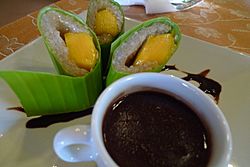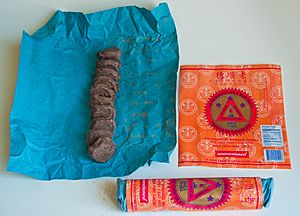Tsokolate facts for kids

Tsokolate with suman
|
|
| Country of origin | Philippines |
|---|---|
| Flavor | Chocolate |
| Ingredients | Chocolate, milk or water, sugar |
| Variants | batirol |
| Related products | Hot chocolate |
Tsokolate is a yummy, thick hot chocolate drink from the Philippines. It's made from special chocolate tablets called tabliya (or tablea), which are pure ground cacao beans. These are mixed with water and milk.
Just like some hot chocolates in Spain and Mexico, Tsokolate is traditionally made in a special pot called a tsokolatera. A wooden whisk called a molinillo is used to mix it quickly. This makes the drink wonderfully frothy! Tsokolate is usually sweetened with a little muscovado sugar and has a unique grainy texture.
People often enjoy Tsokolate for breakfast with traditional rice cakes called kakanin or with pandesal (a type of bread). It's also super popular during the Christmas season in the Philippines, especially with kids!
Contents
What's in a Name?
The name Tsokolate comes from the Spanish word chocolate. This word originally came from Nahuatl, an old language spoken in Mexico.
In different parts of the Philippines, Tsokolate has other names too!
- In Kapampangan, it's called suklati.
- In Maguindanao, it's sikulate.
- In Visayan languages, you might hear it called sikwate or sikuwate.
Meet Tabliya: The Chocolate Discs
Tabliya (or tablea) are small, round tablets of pure chocolate. The word tabliya comes from the Spanish word tablilla, which means "tablet."
These chocolate discs are usually made at home. First, ripe cacao beans are dried for a few days. Then, their shells are removed, and the beans are roasted. After roasting, they are ground into a thick paste. This paste is then shaped into the little discs or balls you see and left to dry.
Besides making Tsokolate, tabliya is used in many other Filipino desserts. One famous dish is champorado, which is a yummy glutinous rice porridge flavored with chocolate.
How to Make Tsokolate
Making Tsokolate the traditional way is a fun process!
- First, water and milk are boiled in a special pot called a tsokolatera. This pot has a tall neck.
- Once small bubbles appear, the pot is taken off the heat.
- A few tabliya discs are dropped into the hot liquid.
- Muscovado sugar and more milk or cream can be added to make it taste just right.
- Then, a special wooden whisk called a molinillo is put into the pot. You twirl it quickly between your palms to make the drink nice and frothy.
- Finally, the frothy Tsokolate is poured into individual cups.
Today, people also use modern tools like regular whisks, blenders, or milk frothers to get that frothy texture. You can even add other flavors like cinnamon or vanilla. However, using regular cocoa powder instead of tabliya is not recommended, as it won't give you the same special taste or texture.
Tsokolate in Filipino Culture
Tsokolate is a big part of Filipino breakfast! It's often enjoyed with different kinds of kakanin (rice cakes) or bread. Some popular foods to pair with Tsokolate include:
It's also a favorite drink during the Christmas season, especially for children.
In a famous Filipino novel called Noli Me Tangere by José Rizal, there's a part where a character named Padre Salvi is said to serve different kinds of chocolate to his guests. He would give thick chocolate (called espeso) to important guests and watery chocolate (called aguado) to those he thought were less important. This story shows how important Tsokolate was in daily life and even in social customs back then.



